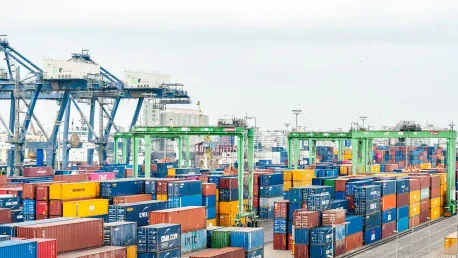Listen to the Article
The logistics industry grows yearly thanks to new technologies, higher consumer expectations, and global economic factors. In 2025, the main trends in supply chain management will likely focus on omnichannel retailing, a wider range of carriers, and better environmental practices. Artificial intelligence and robotics are making the sector more efficient, especially for last-mile delivery in cities.
Key innovations include real-time computing, predictive analytics for supply chains, fully automated delivery vehicles, and product tracking through the Internet of Things. These advancements are changing how companies manage supply chains and meet customer needs. The global market is expected to exceed $18 trillion by 2030, so businesses must adopt new solutions to stay competitive. Here are the main trends and inventions that will shape the future of this field:
1. AI’s Impact on Fresh Food Deliverables
Automation is developing a crucial role in quickly and efficiently transporting perishable goods like food. By 2025, it will help improve the supply chain for essentials such as fruits, vegetables, meat, and dairy products, ensuring they arrive fresh.
Key Benefits of AI in Perishable Food Logistics:
Smart technology offers several benefits that improve the perishable food distribution system. For one, it takes over repetitive tasks like picking inventory and frees up workers for other jobs. Then, it boosts customer satisfaction by predicting which products will be in demand, ensuring they don’t run out during busy times. Furthermore, AI supervises conditions like temperature and humidity to keep products fresh. Lastly, it reduces failures, errors, spoilages, and delays by spotting problems early. Here are some of its best applications:
Smart technology helps maintain proper storage conditions in the warehouse, keeping the temperature of perishable goods at the right level to prevent them from spoiling.
It can predict when equipment like refrigerators or freezers might fail. This is important because disruptions can harm food quality, especially if they cannot be replaced in time.
Machine learning models arrange products so that companies can use space efficiently, helping them make the most of their resources.
Advanced tech also helps reduce delivery routes for refrigerated trucks while lowering fuel costs.
AI helps monitor meat, vegetables, and other products during transportation. The cargo is constantly supervised to ensure it stays at the proper temperatures.
Modern Solutions for SMBs in Food Logistics
Small and medium-sized supply chain management businesses can benefit from using AI tools and platforms. They no longer need to invest in expensive software or hardware like in the past. The integration of computational intelligence allows SMBs to streamline their operations, reduce costs, and enhance customer satisfaction by:
Integrating AI-powered tools that monitor the condition of critical equipment, such as refrigeration units, to prevent unexpected failures.
Optimizing delivery routes and saving money on fuel to ensure that food quality is maintained during transport.
Adopting cloud-based AI platforms so vendors can offer the needed capacity at a low cost compared to outsourcing. This allows innovative and general service providers to quickly and affordably implement advanced solutions in small and medium-sized businesses (SMBs).
Driving Sustainability in Food Logistics
The global food storage and distribution sector is undoubtedly experiencing growing pressure to be sustainable. Self-learning systems can significantly contribute to more sustainable practices:
Minimizing waste by using AI to predict the demand for certain products helps reduce food waste. Many products are used until they spoil, but a well-executed code can help manage this process better.
Optimizing transport by simplifying coordination in mapping and resource management means less energy use during operations, making it better for the environment.
Smart warehouse management reduces energy consumption, as items with higher reoccurrence are placed closer to the stockpickers, thus cutting unnecessary movement.
By 2025, artificial intelligence will transform small and medium-sized businesses (SMBs) in the perishable food industry. Deep learning tools will help manage warehouses, predict when equipment might fail, plan delivery routes, and perform other tasks. This will reduce waste and costs, making products that meet global demands for quality, price, and faster delivery while supporting efficiency and sustainability.
2. On-Demand Shipping: The Backbone of Customer-Centric Logistics
Customers today expect faster delivery services. Many companies use on-demand shipping to meet these needs, offering quick and flexible solutions for getting products out after receiving an order. With mobile apps, GPS, and inventory management, companies can efficiently assign shipments to the proper drivers and reduce delays.
The benefits include speedy deliveries—sometimes within a few hours—without strict limitations and lower costs. Customers appreciate having flexible and early drop-off choices. Businesses can quickly adapt to changing consumer demands, require less inventory, and need fewer fleets and warehouses.
Challenges in Implementing On-Demand Shipping:
Logistics Management Complexity: Handling real-time orders requires a strong system for managing inventory, placing orders, and delivering products. Tailored solutions help businesses avoid setbacks and inefficient operations.
Quality and Reliability: On-demand shipping often relies on third-party transport providers, which makes it challenging to maintain high service quality. The final stages of delivery are very important, so companies must choose their partners carefully and monitor them closely.
Inventory and Storage: Traditional fulfillment models often use centralized storage locations because of on-demand shipping. However, the speed of fulfillment can require decentralized storage. Effective stock control and coordination between facility locations are essential for a successful business.
Last but not least, building strong relationships with reliable third parties is also vital to maintaining service quality. Key issues affecting customer experience and trust include delivering at a specific time, handling deliveries, and return policies. On-demand shipping revolutionizes supply chain management with faster, more flexible delivery options.
3. Next-Gen Lift Trucks Advancing Material Handling Efficiency
Lift truck technology developed over the last few years enhances operators’ production, safety, and visibility in different businesses. Here are some of the standout features in new truck designs:
Toyota’s Moving Mast Reach Truck: It can lift almost 512 inches and carry up to 5,500 pounds. Its roof and mast are transparent, helping the operator see the forks easily. The lift displays are real-time and accessible on a touch screen, making them more effective.
Phantom Auto’s Remote-Controlled Counterbalanced Truck: This vehicle can be controlled remotely and performs many operations from a distance. It has LiDAR scanners to detect obstacles automatically, nine cameras for better visibility, and two-way audio for communication when operated remotely, as in this case.
Combilift’s Aisle-Master-OP: This articulated transporter is designed for narrow aisles, working in spaces as small as 72 inches wide. It can carry up to 6,000 pounds. The hauler has low floor heights, making getting in and out easier and increasing productivity.
Xtender Battery Regenerator: The Xtender improves lead-acid battery capacity by up to eighty percent using Shark Pulse tech. This innovation reshapes sulfate crystals and provides alarms to test efficiency.
Yale Reliant Technology: This safety mechanism includes automated controls that brake the flatbed as it approaches intersections. This helps prevent accidents and keeps everyone safe.
Noblelift OPH26/OPH26K: The picker extends up to 354 inches, and its proportional handling levers allow for adjustable speed and height. This design makes reaching high places easier and less painful while working.
Raymond’s iWarehouse Integrated Tether System: It ensures the operator’s safety. If the operator disconnects, the setup will slow down the hauler or stop the lift function.
Rocla’s Automated Reach Truck: This semitrailer can operate in aisles 10 feet wide. It has stability control and collision detection features to ensure safe use during high-reach tasks. It can reach heights of up to 33 feet.
Hyster’s E80XNL: This flatbed runs on a lithium-ion battery and can carry up to 8,000 pounds. It is designed for heavy operations and has fast charging capabilities. This makes it easy for the operator to use and improves its maneuverability as a mobile elevating work platform (MEWP).
New and advanced lift vehicles are now available, improving how materials are handled in different industries. These transporters offer better visibility, security, and productivity. They feature high-visibility systems and innovative applications for battery regeneration and operator safety, making them leaders in future trends.
Key Takeaways: Navigating the 2025 Transportation Evolution
The logistics plan for 2025 focuses on energy and innovation while meeting the changing needs of customers. This vision shows a change in perishable food transportation thanks to improvements in AI and automation. There is also a growing focus on on-demand shipping, which is made possible by advanced lift trucks. Companies that use innovative technologies—like artificial intelligence, real-time updates, and better material handling—will be more ready to meet the rising demand for fast and flexible deliveries. These trends will play a key role as supply chain management changes, helping businesses stay relevant in a shifting market. The future of distribution is here, and those who adopt these inventions will be well-prepared to thrive in 2025 and beyond.









